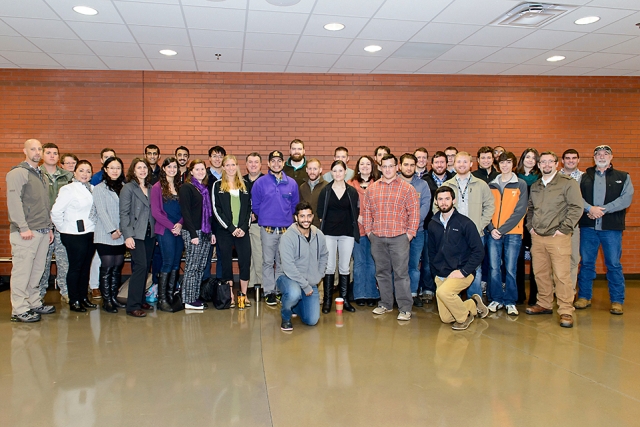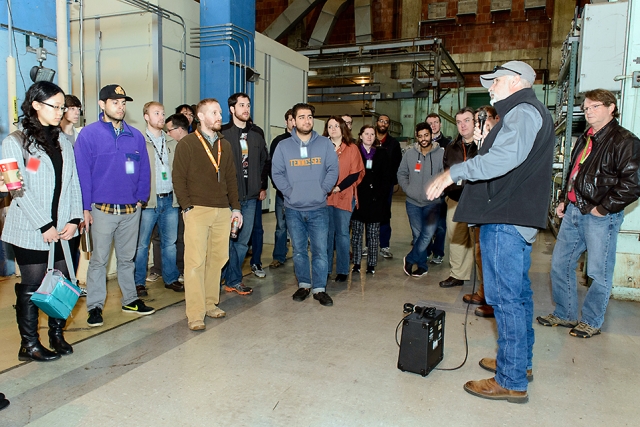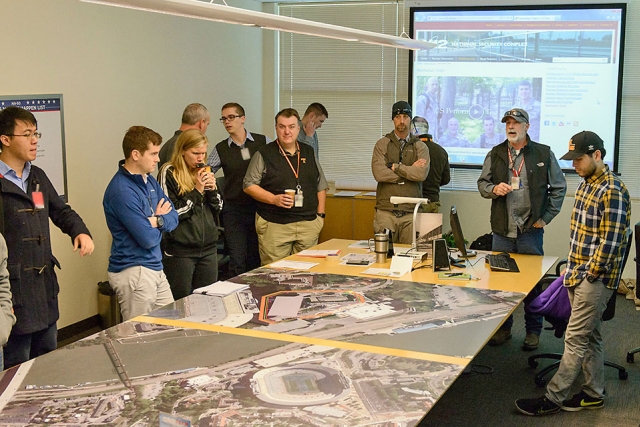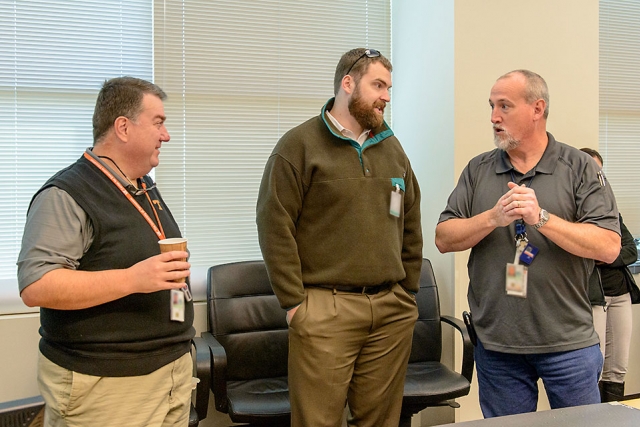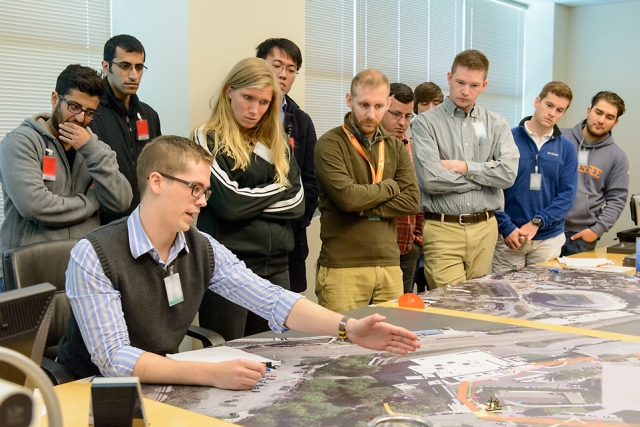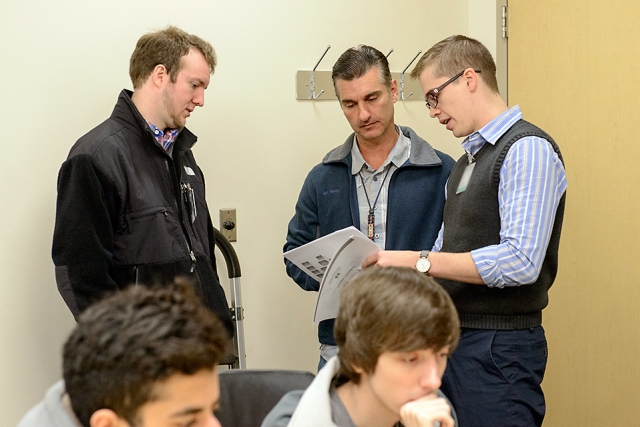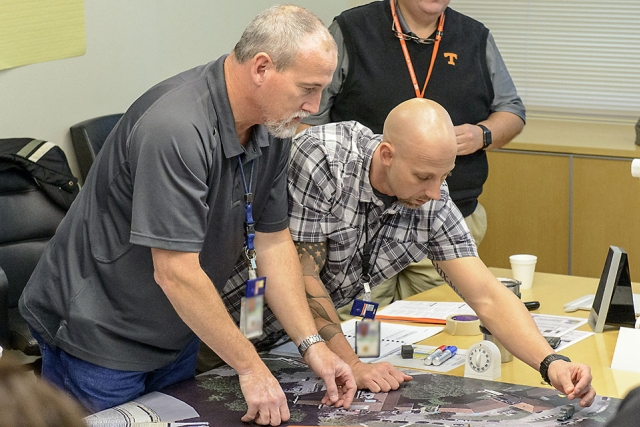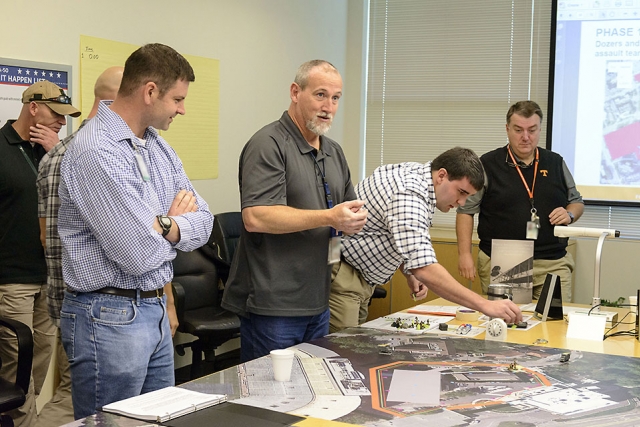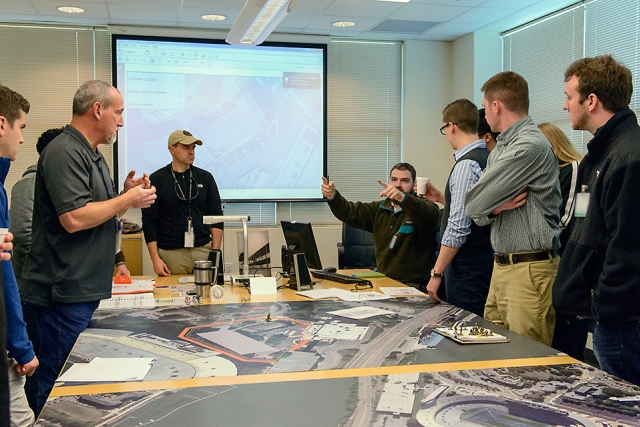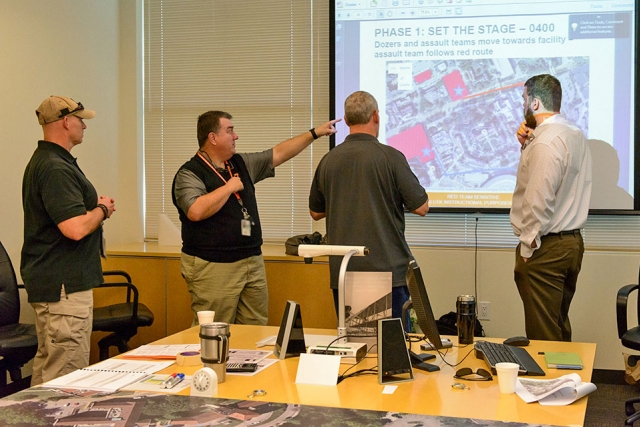Y-12 Blog
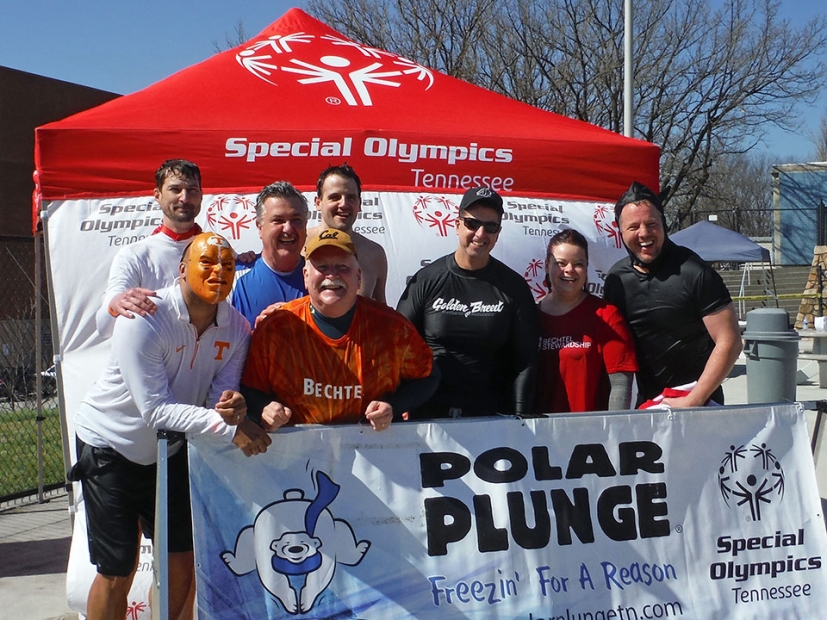 UPF employees collected donations to determine who would take the Polar Plunge, a leap into the University of Tennessee’s outdoor swimming pool.
UPF employees collected donations to determine who would take the Polar Plunge, a leap into the University of Tennessee’s outdoor swimming pool.
Managers from the Uranium Processing Facility raised nearly $9,000 for Special Olympics Tennessee by leaping into ice cold water on Feb. 27 as part of the Polar Plunge, an annual fundraising effort.
UPF was the top fundraising team in Knoxville, contributing 45 percent of the total amount raised in the city, and four UPF managers — Aaron Love, Tony Giordano, Matt Nuckols and Jim Sowers — were the top individual fundraisers. Other UPF participants were Bob Bentley, Mark Braccia, Joe Brown, Jesse Jones, Mike Pratt and Bryan Roberts.
Nominees collect donations to determine who will take the Polar Plunge, a leap into the University of Tennessee’s outdoor swimming pool. At UPF, it was a hotly contested race until the polls closed on Feb. 25. Ultimately, Deputy Engineering Manager Aaron Love edged out Deputy Project Manager Tony Giordano for the top spot by a mere two votes, raising $1,857.
“Thanks to good-natured competition and the generosity of UPF personnel, we led the city in fundraising for this great cause,” said NextGen president Amit Patel.
NextGen is an employee resource group focused on supporting the orientation, development, retention and empowerment of employees as they begin and build their careers.
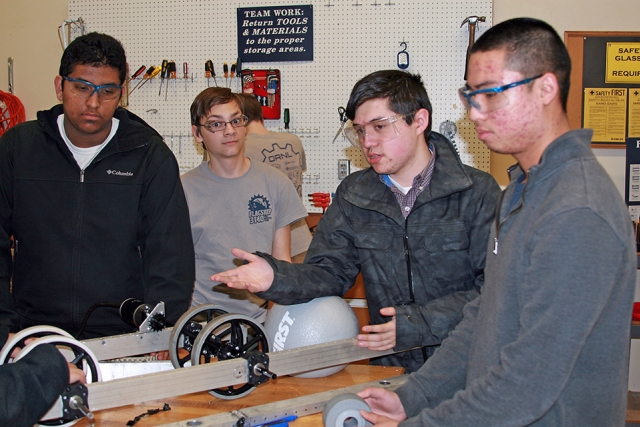 Students from Farragut High School work on their entry for the FIRST (For Inspiration & Recognition of Science & Technology) robotics competition.
Students from Farragut High School work on their entry for the FIRST (For Inspiration & Recognition of Science & Technology) robotics competition.
Consolidated Nuclear Security, LLC plays an active role in strengthening the quality of FIRST (For Inspiration & Recognition of Science & Technology) robotics competitions for individual high school–aged teams in Tennessee and Texas that compete head to head on a special playing field with robots they have designed, built and programmed. FIRST was founded in 1989 to inspire students’ interest and participation in science and technology.
CNS sponsors the Smoky Mountain Regional competition as well as individual teams at: Robertsville Middle; L & N STEM; and Austin East, Bearden, Bushland, Caprock, Farragut, Hardin Valley, Oak Ridge, Roane and Webb high schools.
In addition to the company’s support, CNS engineers work as volunteer mentors on local teams to educate and support tomorrow’s scientists, engineers and mathematicians. “This is exactly the type of activity CNS wants to support,” said Keith Kitzke, a CNS engineer. “This is one of the best activities I have seen for developing team-building and problem-solving skills in high school students.”
On January 8 inventor and FIRST founder Dean Kamen launched the 2016 season with the release of the FIRSTSTRONGHOLD competition. The game changes yearly, keeping the excitement fresh and giving each team a more level playing field. More than 75,000 high-school students representing more than 3,100 teams at 114 venues around the globe joined the FIRST Robotics 2016 Kickoff via live broadcast hosted by Comcast NBCUniversal. This season’s FIRST competition involves alliances (with other schools) of robots on a quest to breach their opponents’ fortifications, weaken towers and capture the opposing tower. “This competition will test the effectiveness of each robot, the power of collaboration and the determination of the students,” said Jane Skinner, Farragut High School coach. “This program is important to our students and impacts each of them in valuable ways.”
Marvin J., a student on the team, validated Skinner’s statement. He said, “For me, FIRST has helped improve my knowledge all around. It has helped me better understand the influence of technology and engineering in everyday life.” He also noted that participating in the competition expanded his knowledge regarding everyday tools and the importance of teamwork, which enhanced his collaborative skills.
FIRST robotics teams are in phase one, which is the six-week design and build phase of their team robot. Phase two of the robotics season involves seven weeks of competition in districts or regions. The Smoky Mountain Regional competition will take place at Knoxville’s Thompson-Boling Arena March 30–April 2, 2016. The championships will take place in April.
For more information about the competition visit TNFIRST or firstinspires.org.
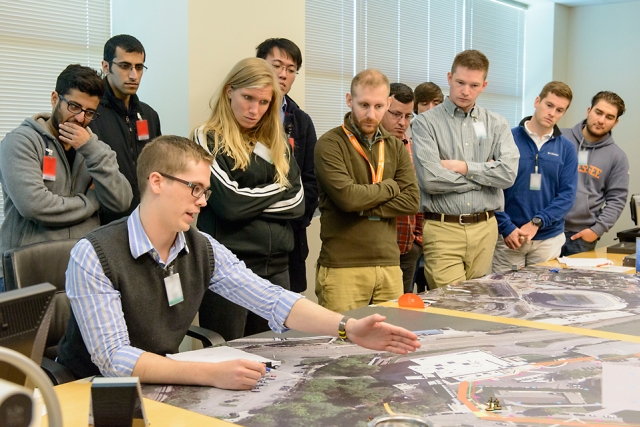 UT students and Y‑12 nuclear security subject matter experts conduct a battle board challenge in Oak Ridge.
UT students and Y‑12 nuclear security subject matter experts conduct a battle board challenge in Oak Ridge.
It’s like a semester‑long chess game with the final moves played live at Y-12 National Security Complex. Consolidated Nuclear Security, LLC nuclear security training experts and University of Tennessee graduate students strategize over a 3‑dimensional battle board during the culmination of an intense college course — a simulated, practical, force‑on‑force, military‑type exercise in which the victors control the virtual cached enriched uranium.
As part of the CNS and UT partnership, Y‑12 experts and UT students work together throughout the semester and then lay it all out on the table in a fierce, calculated half‑day challenge. Dr. Howard Hall, Governor’s Chair Professor at UT, teaches the Nuclear Security Science and Analysis course, working closely with KJ Maddux and others at Y‑12, to offer well rounded training for our nation’s next generation of nuclear security decision makers. “I don’t know of another program like this outside Tennessee,” said Hall. “We have a unique opportunity to work with nuclear security experts as part of the Institute for Nuclear Security, and we conduct our final exercise inside the perimeter of a nuclear facility. This battle board event is definitely the highlight of the semester. Through this training, we’re making a significant impact on the future workforce.”
The INS was founded to increase cooperation between government and academia to solve crucial problems in global nuclear security. As a top‑tier graduate program in nuclear engineering, UT attracts students from around the world. In addition to CNS and UT, INS members include the Howard H. Baker Jr. Center for Public Policy, Oak Ridge National Laboratory and Oak Ridge Associated Universities. “Nuclear security carries tremendous domestic and international importance,” said Maddux, senior program manager for Global Security Analysis & Training at Y‑12. “It’s critical for institutions in academia, industry and government to partner. The INS goal is to create opportunities for its members to interact with one another to attract and educate the next generation of nuclear security experts.”
Y‑12 and UT have completed seven battle board exercises, each with its own flavor. The fall 2015 class of 32 students, which included active‑duty military personnel pursuing advanced degrees, divided into teams early in the semester. The red team played the adversaries (bad guys) and the blue team acted as the protective force (good guys). They held frequent, separate strategy meetings to build their attack/defense of a mock nuclear facility.
The red team’s goal was to infiltrate a mock facility; the blue team was well prepared and ready for an attack, with multi‑tiered tactics in place to defend the facility and the stored nuclear material. The teams moved back and forth, deliberating in separate rooms between turns, taking their best guess at the other team’s next play on the board. This year, the blue team reigned, protecting the nuclear material and leaving the red team with just one man standing.
“Y‑12 is a gem with about 15 subject matter experts available to help the UT students understand and experience physical security, vulnerability analysis, performance testing, safeguards and security, and nuclear materials control and accountability,” said Maddux. He has 30 years of broad experience in the nuclear security field and works closely with Hall to ensure the students receive a healthy balance of classroom and hands‑on training.
Hall, world renowned in the intervention of nuclear terrorism, brings a wealth of field experience to the classroom. Before joining the UT’s nuclear engineering staff in 2009, he worked at Lawrence Livermore National Laboratory and supported the Department of Homeland Security. “We’re educating grad students — from nuclear engineers to writers — about nuclear weapons, material security and crimes. We truly value our unique partnership with CNS,” he added.
Throughout the exercise at Y‑12, senior managers observed the battle board challenge and addressed the students to offer sound advice and words of encouragement. “The world is a dangerous place. Now, more than ever, we need the next generation to step forward and face the challenges of securing nuclear materials,” Bill Tindal, Y‑12 site manager, said. “I applaud you for choosing this field of study. Our world will be counting on you.”
At the semester’s end, UT’s grad students took away their final grade and unmatched national security experience, leaving the virtual cached enriched uranium safe and secure.
Joining forces, CNS and the University of Tennessee offer well rounded training — both on the Knoxville campus and at Y-12 — for our nation’s next generation of nuclear security decision makers. Y-12 recently hosted a tour and 3-D battle board challenge for graduate students. The exercise involved strategic moves by a team protecting a mock nuclear facility and a team attacking the facility to control the stored nuclear material.
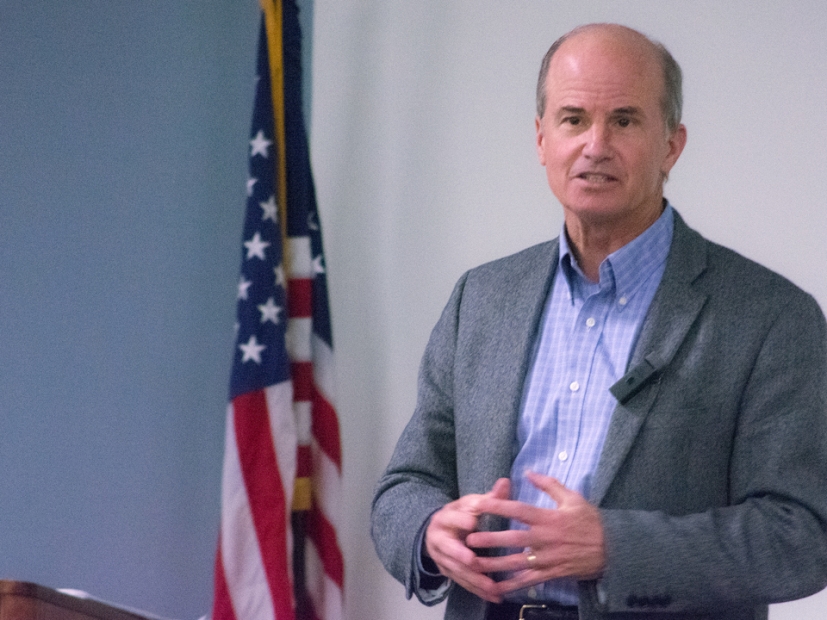 Gen. Kevin Chilton, former commander of U.S. Strategic Command, spoke to Pantex employees and thanked them for their service.
Gen. Kevin Chilton, former commander of U.S. Strategic Command, spoke to Pantex employees and thanked them for their service.
Gen. Kevin Chilton, former commander of U.S. Strategic Command, recently spoke to Pantex employees and delivered a clear message: “From the bottom of my heart, thank you for what you do every single day.” During the Jan. 26 all hands address, he encouraged employees to be proud of themselves, calling the mission “unique,” “vital” and “special.”
Chilton, who is now working with Consolidated Nuclear Security to support Pantex and Y-12 missions, was at Pantex as a member of a Technical Advisory Board focused on enhancing mission delivery. His talk with employees emphasized the importance of the CNS mission, linking employees’ roles to the broader nuclear deterrent.
“One thing I’m certain of, folks, is that we in this room, our children, grandchildren and great-grandchildren will absolutely need and depend on every one of you and the work you do to provide security for them and our great country,” he said. “For that and your dedicated and hard work, I thank you again.”
And he noted that more work will be coming to Pantex and Y-12 as nuclear weapons work ramps up in the coming decades.
“The cycle is picking up right now, and it’s picking up fast. There is a tremendous amount of work to be done, and there are those who doubt we can do it,” Chilton said. “And then there are those like me who are counting on folks like you to make it happen because we have to make it happen. It’s just so important to our country.”
In addition to thanking employees for their work, Chilton explained that the purpose of the United States’ nuclear stockpile is to deter and assure — deter those who think striking us wouldn’t be so bad and assure our allies that the U.S. can provide protection. Chilton said our nation has used nuclear weapons as a deterrent every day since they were first fielded. “We have been 100 percent successful,” he noted.
Aside from stressing the importance of a strong nuclear deterrent and the role CNS plays, he peppered his remarks with stories of his days as the commander of STRATCOM, his long and prestigious Air Force career and his service at NASA, where he was on three space shuttle missions: Endeavour (1992), Endeavour (1994) and Atlantis (1996), which he commanded.
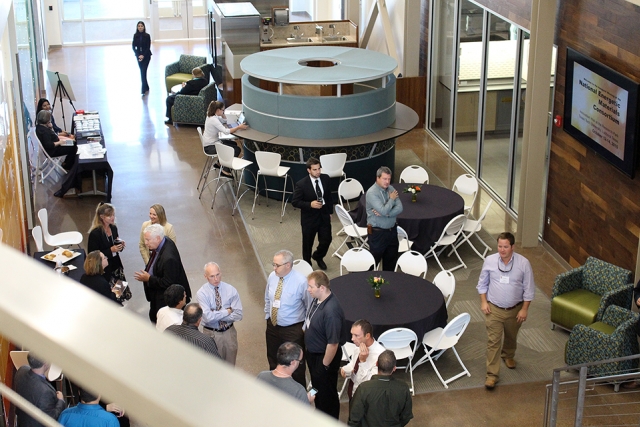 CNS was well represented at the first National Energetic Materials Consortium.
CNS was well represented at the first National Energetic Materials Consortium.
About 70 university researchers and government and industry experts from across the country, including Consolidated Nuclear Security employees, joined forces at the first ever National Energetic Materials Consortium hosted by Texas Tech University.
Pantex’s Christopher Young said, “There are a great many types of energetic materials and an array of applications. The explosives used by the Department of Energy are a specialized subset and have very stringent requirements in regards to their precision, timing, reproducibility, sensitivity and ageing characteristics.”
NEMC was formed by leading universities across the U.S. to combine technology and science within the academic community with the manufacturing resources of private industry. The aim is to bring critically needed innovations to the energetics sector of the national technological industrial base; NEMC is designed to allow for a rapid transition of new materials to a modernized industrial base.
“Acceptance and performance testing of explosives has been accomplished at Pantex for DOE since the 1960s,” Young said. “We’ve teamed up with Los Alamos National Laboratory and Lawrence Livermore National Laboratory on this work. Current data acquisition strategies are continuously balanced against new technologies and ever evolving requirements.”
There was a strong showing from Pantex and Y-12 presenters.
Pantexan Patrick Goguen said, “It was a great opportunity to share ideas with some of the leaders in academia, government and industry related to advancing the frontiers of energetic materials. Rarely can you get such a diverse audience together to have such a focused interchange.”
CNS was one of the sponsors of the event, held in Lubbock, Texas, and is collaborating with Texas Tech University in research and development areas.

